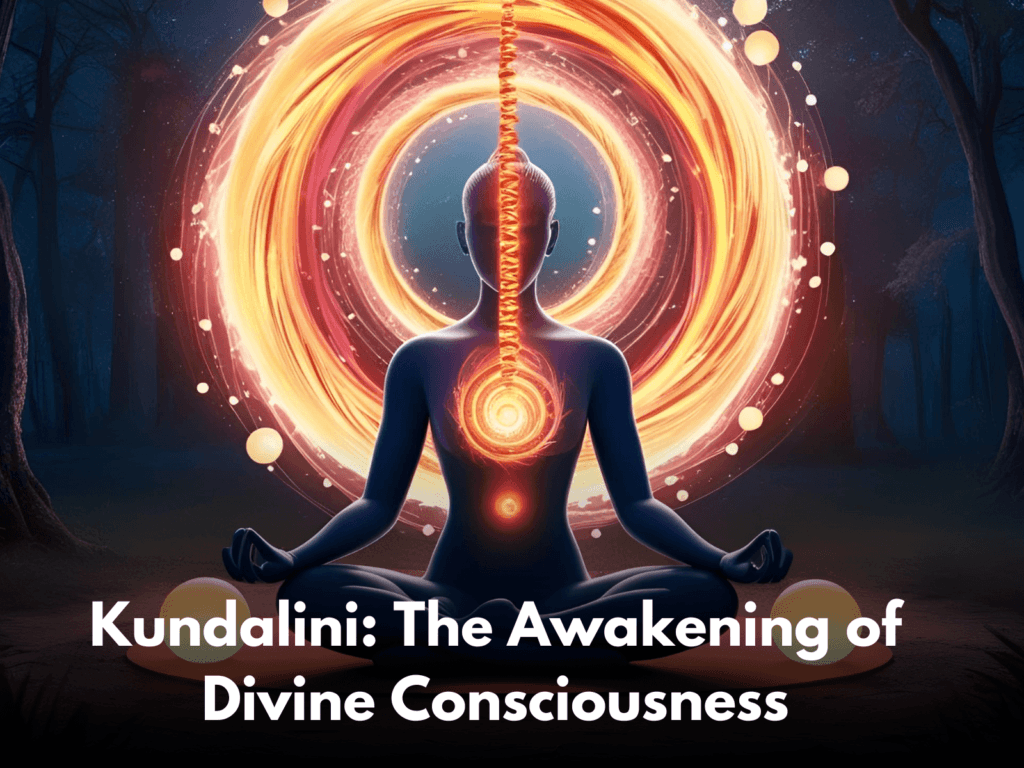
Kundalini: The Awakening of Divine Consciousness
April 17, 2025
Kundalini: The Awakening of Divine Consciousness
What is Kundalini?
Kundalini is the dormant divine energy residing at the base of the spine, coiled like a serpent in the Mooladhara Chakra. It is the ultimate force of consciousness that, when awakened, leads to spiritual enlightenment and self-realization. The word “Kundalini” originates from Kunda, meaning a coiled form, symbolizing latent potential within every human being.
Ancient yogic texts describe Kundalini as the embodiment of Shakti, the cosmic energy that fuels existence. When this energy ascends through the Sushumna Nadi, it passes through the seven chakras, activating deeper states of awareness and unlocking the hidden faculties of the mind.
The Shiva Samhita (5.224) states:
“यत्र यत्र स्थितं चित्तं केनचिद्विषयस्थितम्।
तत्र तत्र समाधिस्यादेतद्देवस्य लक्षणम्॥”
“Wherever the mind dwells, be it on any object, there itself one attains Samadhi. This is the mark of the divine.”
The Discovery of Kundalini
From ancient times, sages and seers observed that certain individuals possessed extraordinary abilities—clairvoyance, intuitive wisdom, profound artistic genius, or immense physical and mental strength. These abilities stemmed from the awakening of a hidden force within.
Through intense Tapasya (austerity), Dhyana (meditation), and Pranayama (breath control), these sages discovered that Kundalini is the key to unlocking the higher dimensions of human consciousness.
Swami Vivekananda emphasized this latent potential, saying:
“There is a divine energy sleeping within us. When it awakens, we realize that we are none other than Brahman itself.”
The Path of Kundalini Awakening
The awakening of Kundalini is a gradual and disciplined process. The most effective methods include:
- Mantra Japa – Chanting sacred sounds to harmonize inner vibrations.
- Dhyana (Meditation) – Deep concentration on divine light or inner silence.
- Pranayama – Regulated breathing to activate the Sushumna Nadi.
- Tapasya – Austerities to purify the mind and body.
- Shaktipat – The transfer of spiritual energy from a realized master.
Swami Vivekananda, a strong advocate of meditation, stated:
“Meditation is the focusing of the mind on an internal or external object with the exclusion of all else.”
The Chakras: Gateways to Higher Consciousness
The human energy system consists of thousands of Nadis (energy channels), but the three primary ones—Ida, Pingala, and Sushumna—are crucial for spiritual transformation. Along the Sushumna, seven principal chakras regulate different aspects of our existence.
Mooladhara Chakra (Root) – The Foundation of Existence
- Location: Base of the spine
- Element: Earth
- Mantra: Lam
- Significance: Governs stability, security, and survival.
- Effect of Awakening: Eliminates fear and establishes inner strength.
Swami Vivekananda emphasized that a strong foundation is essential for spiritual growth.
Swadhisthana Chakra (Sacral) – The Ocean of Emotions
- Location: Below the navel
- Element: Water
- Mantra: Vam
- Significance: Controls creativity, desires, and emotions.
- Effect of Awakening: Transforms lower desires into divine devotion.
Manipura Chakra (Solar Plexus) – The Fire of Willpower
- Location: Navel region
- Element: Fire
- Mantra: Ram
- Significance: Seat of personal power, will, and transformation.
- Effect of Awakening: Burns past karma and strengthens determination.
The Bhagavad Gita states:
“The fire of yoga burns away all impurities and limitations.”
Anahata Chakra (Heart) – The Center of Love
- Location: Center of the chest
- Element: Air
- Mantra: Yam
- Significance: The seat of compassion, love, and devotion.
- Effect of Awakening: Leads to selfless love and higher spiritual experiences.
The Upanishads describe:
“Deep within the cave of the heart, the eternal dwells.”
Vishuddha Chakra (Throat) – The Power of Expression
- Location: Throat
- Element: Ether
- Mantra: Ham
- Significance: Governs communication, purity, and wisdom.
- Effect of Awakening: Enhances speech, clarity, and divine knowledge.
Ajna Chakra (Third Eye) – The Command Center
- Location: Forehead, between the eyebrows
- Element: Beyond elements
- Mantra: Om
- Significance: The center of intuition and higher perception.
- Effect of Awakening: Grants inner vision and divine insight.
Swami Vivekananda emphasized concentration on this chakra for spiritual enlightenment.
Sahasrara Chakra (Crown) – The Thousand-Petaled Lotus
- Location: Top of the head
- Element: Beyond elements
- Mantra: Silence (pure consciousness)
- Significance: The state of union with the divine.
- Effect of Awakening: Liberation (Moksha) and self-realization.
The Yoga Vashistha declares:
“Where duality ceases, there the supreme reality begins; that alone is Brahman.”
Meditation Techniques for Kundalini Awakening
Swami Vivekananda’s Meditation on Om
- Sit in a comfortable position.
- Close your eyes and take deep, steady breaths.
- Focus on the space between the eyebrows (Ajna Chakra).
- Chant “Om” silently within.
- Observe thoughts without attachment, allowing the mind to dissolve into silence.
Dynamic Meditation
- Begin with rapid breathing to clear mental blocks.
- Move the body freely (dance, shake, or stretch) to release trapped energy.
- Enter a state of deep stillness and surrender to inner peace.
Breaking Generational Karmic Curses
Kundalini awakening is not just a personal transformation—it also purifies Pitri Dosha (ancestral karmic debts). When one attains higher consciousness, their entire lineage benefits.
The Bhagavad Gita (6.41) states:
“One who has engaged in spiritual practice is reborn in a pure and noble family, continuing the path toward liberation.”
The Ultimate Union: Shiva and Shakti
The awakening of Kundalini is the sacred union of Shakti (energy) with Shiva (pure consciousness). When Shakti ascends through the chakras and merges with Shiva at the Sahasrara, the seeker experiences absolute bliss and divine realization.
The Shiva Sutras declare:
“He who awakens Kundalini becomes one with the infinite.”
Conclusion: The Liberation of the Soul
Kundalini is the bridge between the mortal and the divine. Awakening it means transcending all limitations—physical, emotional, and karmic—to attain supreme bliss (Ananda). The journey requires discipline, devotion, and divine grace, but the reward is ultimate freedom.
As Swami Vivekananda urged:
“Arise, awake, and stop not till the goal is reached!”
